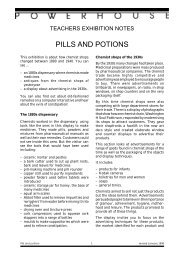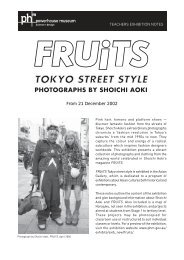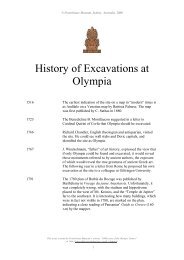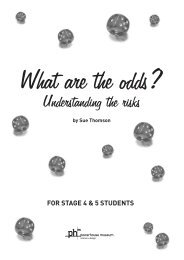design across time - Powerhouse Museum
design across time - Powerhouse Museum
design across time - Powerhouse Museum
Create successful ePaper yourself
Turn your PDF publications into a flip-book with our unique Google optimized e-Paper software.
+ 09 powerline spring 05<br />
William Kerr<br />
epergne<br />
About 24 large silver<br />
presentation centrepieces<br />
were made in Australia in the<br />
19th century, only about half of<br />
which have survived. This<br />
piece, an epergne or table<br />
centrepiece, was made in the<br />
workshop of leading Sydney<br />
silversmith William Kerr in the<br />
late 1800s. Born in Northern<br />
Ireland, Kerr came to the<br />
colony of NSW with his family<br />
as a child in 1841.<br />
Standing 72 cen<strong>time</strong>tres high,<br />
this tour de force of Australian<br />
silversmithing was made to<br />
celebrate the success of the<br />
first Australian cricket team to<br />
tour Britain. It depicts a cricket<br />
Hanssen Pigott<br />
‘still life’<br />
Gwyn Hanssen Pigott (b 1935)<br />
is one of Australia’s most well<br />
known and respected ceramic<br />
artists, with an established<br />
reputation both in Australia<br />
and overseas. Inspired first by<br />
the work of Australian potter<br />
Ivan McMeekin in the 1950s,<br />
she went on to work with<br />
Bernard Leach and Michael<br />
Cardew in England in the ’60s,<br />
and was also influenced by<br />
modernists such as Lucie Rie<br />
(all of whom are represented<br />
in the Inspired! exhibition).<br />
Later, attracted by the<br />
freshness and vigour of<br />
traditional woodfired French<br />
stonewares, she set up a<br />
match taking place under a<br />
large Australian native tree<br />
fern, with flannel flowers,<br />
bottle brush, goannas and<br />
snakes on the ground. The<br />
use of native decorative motifs<br />
in Australian 19th century<br />
sporting trophies is rare as<br />
sport was firmly rooted in<br />
British culture, and <strong>design</strong>s<br />
mostly emulated English<br />
models. Although <strong>design</strong>ed as<br />
a trophy, it was never actually<br />
presented. Instead it is<br />
thought to have stood as a<br />
display piece in the window of<br />
Kerr's George Street shop in<br />
Sydney. It was donated to the<br />
<strong>Museum</strong> by the Kerr family<br />
when the shop closed in 1938.<br />
Eva Czernis-Ryl, Curator,<br />
Decorative Arts and Design<br />
EPERGNE OF SILVER, EMU EGGS, GLASS AND WOOD, MADE BY WILLIAM KERR,<br />
SYDNEY, 1879. 72 X 40 CM. GIFT OF W T KERR, 1938. PHOTO BY PENELOPE CLAY.<br />
pottery in rural France, before<br />
returning to Australia in 1973.<br />
In the early 1970s she saw the<br />
work of the ‘still life’ painter<br />
Giorgio Morandi, and wrote: ‘I<br />
love his searching, obsessive,<br />
describing of the common<br />
objects that were his subject<br />
and measure.'<br />
This group is characteristic of<br />
the work Hanssen Piggot has<br />
been making for many years.<br />
Arranging finely made<br />
domestic forms into groups<br />
she calls ‘still lives’ or,<br />
some<strong>time</strong>s, 'families', she<br />
wants them to be considered<br />
in a way that ‘might raise a<br />
question, lengthen a glance’.<br />
Grace Cochrane, Senior<br />
Curator, Australian Decorative<br />
Arts and Design<br />
‘STILL LIFE WITH YELLOW BOWLS’, WHEELTHROWN AND SLIPCAST IN LIMOGES<br />
PORCELAIN AND SOUTHERN ICE PORCELAIN, MADE BY GWYN HANSSEN PIGOTT,<br />
2002. PURCHASED 2002. PHOTO BY MARINCO KOJDANOVSKI.<br />
GLASS AND GILT VASE MADE BY LEGRAS & CIE, FRANCE, ABOUT 1905, 65 X 18 CM.<br />
PURCHASED WITH FUNDS PROVIDED BY THE AUSTRALIAN DECORATIVE AND FINE<br />
ARTS SOCIETY, KURING-GAI, 2004. PHOTO BY JEAN-FRANCOIS LANZARONE.<br />
Legras & Cie vase<br />
This spectacular blown-glass<br />
vase was made in about 1905<br />
by the Paris glassworks<br />
Legras & Cie, which<br />
specialised in acid-etched<br />
and enamelled cameo glass.<br />
During the first decade of the<br />
1900s Legras & Cie became a<br />
major exponent of the École<br />
de Nancy led by Emile Gallé,<br />
France’s leading maker of<br />
decorative glass in the<br />
fashionable Art Nouveau style.<br />
The firm produced a wide<br />
variety of commercial artglass,<br />
both cameo and<br />
painted in enamels, but also<br />
made some large high-quality<br />
pieces for international<br />
exhibitions. Only a few of<br />
these more elaborate<br />
examples have survived. The<br />
large size, unusual <strong>design</strong>,<br />
complex technique (two layers<br />
of transparent green glass<br />
with aventurine spangles<br />
trapped between) and lavish<br />
decoration of this vase<br />
indicate that it may have been<br />
an exhibition piece.<br />
While many of Legras <strong>design</strong>s<br />
of this period used naturalistic<br />
motifs, some, like this vase,<br />
display more stylised<br />
decoration and sumptuous<br />
Rococo rocailles (scrolls). The<br />
decoration on this piece is<br />
based on mistletoe, a motif<br />
perfectly suited to the<br />
curvilinear Art Nouveau style,<br />
but the overall <strong>design</strong> reveals<br />
the influence of the 18th<br />
century Rococo style.<br />
Eva Czernis-Ryl, Curator,<br />
Decorative Arts and Design<br />
Vionnet gown<br />
Madeleine Vionnet (1876–1975)<br />
was best known for her use of<br />
the bias cut, so beautifully<br />
illustrated in this early 1930s<br />
evening dress. By cutting her<br />
fabric at 45° to the grain,<br />
Vionnet created a seductive<br />
and daring look that<br />
contrasted beautifully with the<br />
corseted and stiffened<br />
silhouettes popular for much<br />
of the 19th century. Vionnet’s<br />
<strong>design</strong>s were dramatic and<br />
ingeniously cut, using fabric<br />
with the greatest respect for<br />
its particular qualities.<br />
The bodice of this cream silk<br />
hopsack weave gown is in<br />
three sections, gathered and<br />
held by shoulder straps<br />
inserted into channels which<br />
cross at the back. The straps,<br />
jewelled with aquamarine and<br />
clear faceted glass stones set<br />
into metal mounts, are a<br />
typical Vionnet innovation,<br />
combining jewellery and fabric<br />
in one <strong>design</strong>.<br />
Vionnet’s expertise evolved<br />
from many years of<br />
apprenticeship, observation<br />
and practice both in making<br />
and selling. At 12 years of age<br />
she started her first job and<br />
later worked for Paris<br />
couturiers Callot Soeurs and<br />
Doucet before she set up her<br />
own business in 1912.<br />
Lindie Ward, Assistant<br />
Curator, International<br />
Decorative Arts and Design<br />
Inspired! Design <strong>across</strong> <strong>time</strong><br />
opens on 6 October.<br />
SILK EVENING DRESS MADE BY<br />
MADELEINE VIONNET, PARIS, FRANCE<br />
ABOUT 1930. PURCHASED 1996.<br />
PHOTO BY JEAN FRANCOIS<br />
LANZARONE.
















